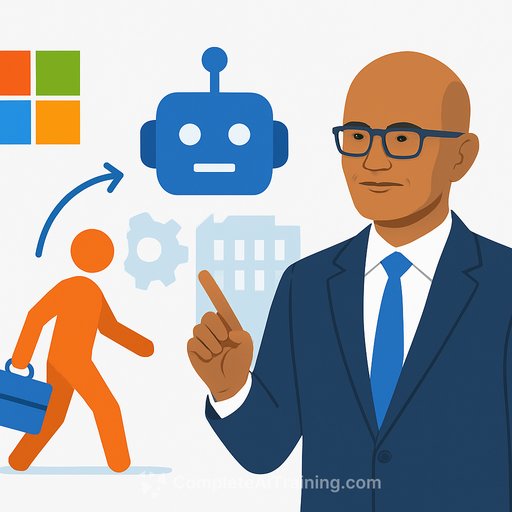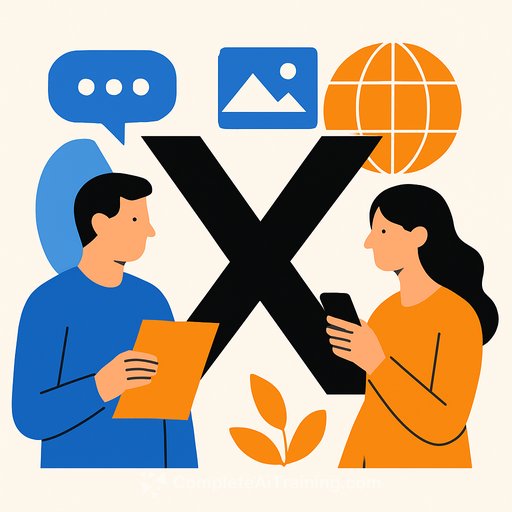Microsoft will hire again - with an AI-first headcount strategy. What HR needs to do now
After a year of layoffs and hiring freezes, Microsoft plans to expand headcount again. CEO Satya Nadella says growth will be different: smaller teams, higher output, and AI threaded into every stage of planning and execution.
On the BG2 podcast with Brad Gerstner, Nadella confirmed Microsoft will increase headcount after cutting roughly 15,000 roles over the past year (including 9,000 in July). The company closed FY2025 with about 228,000 employees. "I will say we will grow our headcount," he noted, "but that headcount will grow with a lot more leverage than we had pre-AI."
He added, "Right now, any planning, any execution, starts with AI. You research with AI, you think with AI, you share with your colleagues and what have you." Microsoft has rebuilt internal workflows around tools like Microsoft 365 Copilot and GitHub Copilot - built on technology from OpenAI and Anthropic - prompting a period of "unlearning and learning" for employees. He compared it to the shift from fax and paper to email and Excel.
The timing stands out. Amazon just announced another 14,000 job cuts, with HR chief Beth Galetti calling AI "the most transformative technology since the Internet." Meanwhile, Microsoft reported 12% revenue growth year over year and its highest operating margin since 2002 - signs that an AI-driven efficiency push can translate into leaner, smarter growth.
What Nadella's comments signal for HR
- Hiring returns, but with stricter productivity math: fewer incremental roles, more output per team.
- AI fluency becomes a baseline, not a bonus. Every function is expected to "start with AI."
- Work is redesigned around AI assistance, automation, and new collaboration loops.
- Reskilling and job redesign will run in parallel with external hiring.
Immediate priorities for HR leaders
- Rebuild workforce plans around "AI leverage" per role. Define what gets automated, what stays human, and where humans + AI outperform either alone.
- Shift from role-based headcount to work-based capacity. Map tasks, not titles, and fund headcount where AI still leaves gaps.
- Set an AI literacy floor. Every knowledge worker should demonstrate prompt fluency, judgment, and tool proficiency.
- Align performance and rewards to outcomes: cycle time, quality, and customer impact - not hours or headcount.
Hiring profiles to update now
- Job descriptions: Add concrete AI responsibilities (e.g., "Use Copilot to draft, analyze, and iterate," "Build and maintain prompt libraries," "Review AI output for accuracy and bias").
- Assessment: Use work samples with AI-in-the-loop. Test tool usage, critical thinking, escalation judgment, and documentation quality.
- Competencies: Problem decomposition, data hygiene, prompt construction, tool chaining, and change resilience.
- Compensation: Calibrate bands to output with AI. Reward teams that reduce cycle time and error rates without bloating headcount.
Reskill and redeploy, fast
Don't wait for perfect org charts. Stand up a rolling redeployment program that moves capable employees into AI-augmented roles with clear 30/60/90-day skill targets.
- Run sprint-based training tied to real projects, not generic workshops.
- Pair training with mentors and tool coaches to compress ramp time.
- Track skill adoption with simple scorecards - prompts used, tasks automated, quality deltas.
Policies and guardrails
- Responsible use: Define where AI can assist, where human review is mandatory, and what data is off-limits.
- Vendor and model risk: Document providers, update DPIAs, and clarify data retention and logging.
- Bias and accuracy: Require audit trails and spot checks. Make it easy to report and correct errors.
- IP and security: Train employees on safe input, redaction, and export controls.
Metrics to manage a leaner, smarter workforce
- Throughput per FTE (before vs. after AI)
- Cycle time to decision or delivery
- Automation coverage by process
- Error and rework rates
- AI skill adoption and active usage
- Cost-to-serve by customer or function
Tools Microsoft is standardizing on
- Microsoft 365 Copilot for knowledge work: drafting, summarization, meeting synthesis, and planning.
- GitHub Copilot for engineering: coding assistance, code review boosts, and documentation.
90-day HR action plan
- Weeks 1-2: Pick three priority workflows per function. Baseline current throughput, quality, and cost.
- Weeks 3-6: Pilot AI-assisted SOPs with small teams. Add prompts, review steps, and escalation rules. Measure the lift.
- Weeks 7-10: Update job descriptions, interview loops, and performance rubrics to reflect AI-in-the-loop work.
- Weeks 11-13: Expand pilots, sunset low-value tasks, and redeploy talent to higher-value work.
Upskilling resources for HR teams
- AI courses by job function - quick paths for HR, recruiting, L&D, and operations.
- AI automation certification - build hands-on skills your team can apply immediately.
Bottom line for HR: Microsoft's next hiring cycle isn't about rebuilding the same org with fresh faces. It's about assembling smaller teams that move faster because AI sits at the starting line of every plan and every deliverable. Calibrate your hiring, reskilling, and policies to that standard now.
Your membership also unlocks:






